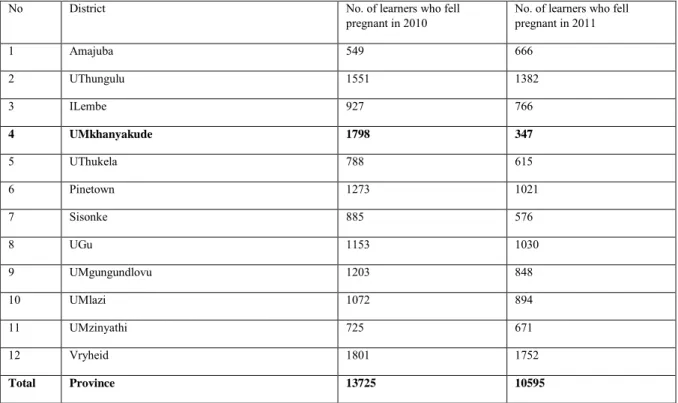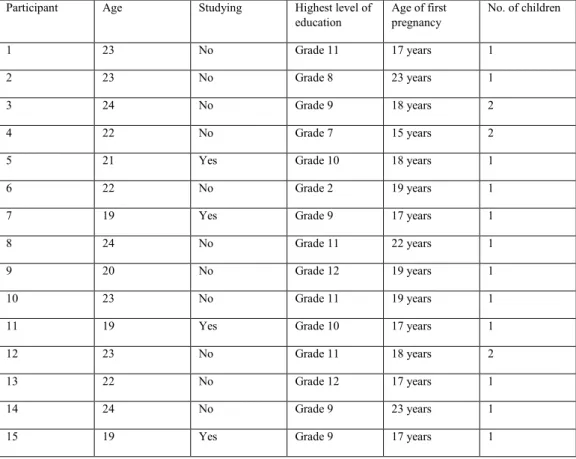This thesis is being submitted for the degree of Masters in Development Studies in the College of Humanities under the School of Built Environment and Development Studies, University of KwaZulu-Natal, Durban, South Africa. Women from the study argue that there are several factors that contribute to early labor, especially in the community in which they live.
INTRODUCTION
- Introduction
- Rationale of the study
- Aims and Objectives
- The theoretical framework
- The organisation of the study
The CSG is one of the most important cash transfers provided by the government in South Africa for poverty alleviation. The overall aim of the study was to investigate the relationship between early pregnancy and the CSG.
LITERATURE REVIEW
Introduction
Similarly, a study conducted by the provincial Department of Health examining factors associated with teenage pregnancy reported similar results regarding early delivery. The results of the study showed that 71 percent of pregnancies were unwanted and 29 percent were wanted (Directorate of Population and Development, 2012).
Consequences of early childbearing
- Physical consequences
- Social consequences
- Psychological consequences
Accordingly, teenage mothers are more likely to be socioeconomically disadvantaged in later life compared to those who delayed pregnancy (Sodi, 2009). Teenage mothers are less likely to complete schooling and are more likely to have children who are at greater risk of major learning and developmental difficulties than older mothers (Brace et al., 2008).
The relationship between the Child Support Grant and early childbearing
The aim of the research was to understand the gender dynamics and impact of the CSG. The aim of this study was to investigate early pregnancy in the context of the CSG.

The impact of the CSG
- Impact on school
- Impact on health and nutrition
- Impact on child labour
- Employment and economic improvement
- Foods items
Causes of early childbearing
- Sexual risk behaviour
- Contraceptives use, knowledge and access
- Sex education
- Culture and religion
- Communication
International research reports that only 40 percent of young people aged 15 to 24 have correct knowledge about HIV and its transmission (Hoffman et al., 2013). In contrast, in the United States, reducing barriers to contraceptive access has been found to be effective in reducing teenage pregnancy and sexually transmitted infections (Kohler et al., 2008). The results of this study show that youth who received comprehensive sex counseling were unlikely to report teenage pregnancy compared to those who received formal sex counseling (Kohler et al., 2008).
Communication with young people about sex and sexuality plays a major role in achieving sexual health among this group (Ogle et al., 2008). However, it has been found that it becomes easier for young people to communicate about sex with their sex partners if they have had open discussions about sex matters with their parents (Ogle et al., 2008).
Summary
In addition, the conclusion of this study agreed with the idea that "mothers who communicate with their daughters about sex can positively influence their daughters' sexual behavior" (Hutchinson et al., 2003:98). Because of the high prevalence of sexually transmitted infections and pregnancy in the United States, some organizations have developed interventions aimed at teaching parents communication skills about how to communicate with their children about sexuality and contraception (Jaccard et al., 2002). This approach is thought to be valuable because parents are seen as agents of change and important sources of information and advice that can help shape and change their children's sexual beliefs and behaviors (Jaccard et al., 2002).
METHODOLOGY
- Introduction
- Study context
- Qualitative methods
- Process of data collection
- Ethical considerations
- Data analysis
- Study limitations
- Summary
The study relied on qualitative research methods using in-depth interviews with recipients of the CSG. In the letter, the purpose of the study was outlined and the letter explained that participation in the study was completely voluntary and the participants. During the selection process, the purpose of the study was explained to the participants and permission was also sought from the elders for the participants who still live with their parents.
Based on the nature of the study and the sampling method used to select the participants, the researcher collected data using in-depth interviews. To reduce the limitations, the researcher also provided contact information of the supervisor to the participants and this was also helpful because it helped establish the reliability of the study.

RESULTS
Introduction
Many of the participants were school dropouts, the reason for dropping out of school was that some of them became pregnant and their parents forced them to stay at home to look after their children. Another reason was finances; a few of them had to leave school because their parents did not have enough money to finance their studies. Some of them reported that their parents had passed away so they had to leave school and look for temporary work.
It is worth noting that they considered their temporary jobs as the main source of income. Those who were still attending school reported receiving financial support from their families.
Challenges experienced by young mothers
- Physical challenges
- Psychological challenges
- Social challenges
One of the participants reported that she had a miscarriage, and the other reported that she gave birth by caesarean section. They reported that they had to drop out of school because their parents forced them to; one of the participants reported that her father disowned her after she told him she was pregnant, and the father did not support her in terms of school fees and other school items such as school uniform. Financial problems were one of the reasons for dropping out of school for some of the participants; one of the participants revealed that she had to drop out of school to look for a part-time job so that she could support her child in the absence of the child's father.
They also reported raising children in the absence of their fathers because their male partners rejected them after telling them they were pregnant. One of the participants revealed that she had to find a part-time job to make ends meet.
Factors that contribute to early childbearing
- Sexual risk behaviour and sugar daddies
- Alcohol consumption
- Contraceptives
- Lack of sex education and lack of recreational facilities
One of the participants argued that during parties young people drank too much alcohol and lost control and ended up sleeping around with random men. One of the participants revealed that young people did not have access to contraception because they feared their parents. Participants claimed that they became pregnant because they did not receive proper sex education; one of the participants argued that there should be experts to teach them about sex relationships in their communities.
One of the participants mentioned that their parents did not teach them about sex issues. One of the participants argued that the reason why many young people were involved in sexual activities was because they did not have facilities to keep themselves busy, facilities such as sports grounds.
Influence of Child Support Grant
- Misconceptions of teenage pregnancy in relation to Child support grant
- The relationship between child support grant and childbearing
Therefore, according to the responses of the participants, they do not have children because they know that they are entitled to the grant. During the interviews, almost half of the participants argued that they did not believe that young people had children because they wanted CSG, but they stated other reasons that could be the cause of pregnancy. They also argue that for them having children was a mistake because they did not plan their pregnancy with the aim of receiving the grant.
Others have children by mistake and not because they want access to the grant, I think so” (P 6). Some participants argued that they did not believe that some people deliberately had children because they wanted the subsidy.
Impact of the Child Support Grant
- The purpose of child support grant
- The usage of child support grant
From this study the findings revealed that mothers spend money on their children's expenses. However, some of them mentioned that sometimes they used part of the money for their expenses. Other participants mentioned that with the money they received from the government, they were able to pay their children's school fees and buy school uniforms and food.
Some participants mention that with the money they received from the grant, they sometimes made savings through banking systems and stokvel clubs. I also save the money I got from the stokvel club; I am saving money for my children's education so that they can use it to pay school fees in the future” (P 5).
Summary
DISCUSSION AND RECOMMENDATIONS
Introduction
In 2005, 9.4 million people out of a total of 47 million people had access to social grants from the South African government and half of these people were children receiving the CSG (Williams, 2007). Recent research conducted in 2011 by the DSD to evaluate the impact of the CSG shows that the CSG has a larger number of recipients compared to other grants; Looking at the above statistics, it appears that the South African government is devising strategies to alleviate poverty.
As is widely known, poverty is one of the challenges still facing South Africa, therefore social grants are still essential in this country to curb poverty. In this study, most participants disagreed with the idea that young women had children because they wanted to receive the grant.
Summary of results
Some participants argue that the CSG was not enough to support themselves and their children; therefore they did not have children because they wanted access to the CSG. Therefore, if young women have children because they want to access the grant, a greater number of children's births will be expected so that they can increase the amount of the grant. The second finding of the study reveals that some participants believed that there were young mothers who had children because they wanted access to the CSG.
The ironic part of this finding is that those participants who said this denied having children because they wanted to receive the CSG. Young mothers do not give birth to children because they want to be entitled to the CSG.
Recommendations
- Sex education
- Access to reproductive health services
- Youth skills development
Gender and social assistance in the first decade of democracy: A case study of South Africa's Child Support Grant. Bus fare tak': The economics of sex and gifts among young people in urban South Africa. The Changing Dynamics of Child Grants in the Context of High Adult Mortality in South Africa: A Simulation to 2015.
Has child support been linked to an increase in teenage fertility in South Africa? An analysis of the impact of child support on teenage fertility rates in South Africa. An overview of teenage pregnancy in South Africa – experiences with education, and knowledge of and access to sexual and reproductive health care.
The Changing Dynamics of Child Grants in the Context of High Adult Mortality in South Africa: A Simulation to 2015.



